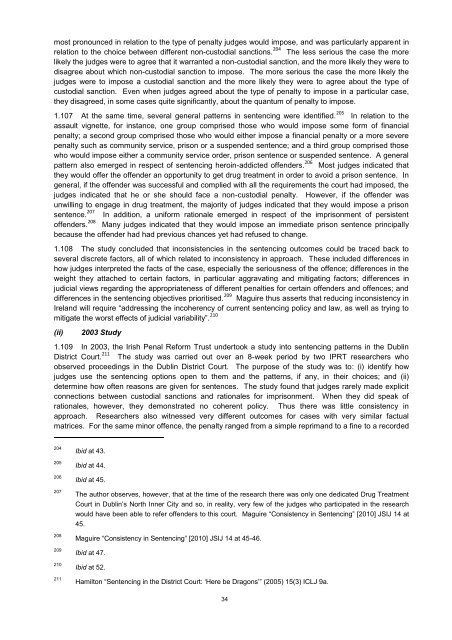Report on Mandatory Sentences - Law Reform Commission
Report on Mandatory Sentences - Law Reform Commission
Report on Mandatory Sentences - Law Reform Commission
Create successful ePaper yourself
Turn your PDF publications into a flip-book with our unique Google optimized e-Paper software.
most pr<strong>on</strong>ounced in relati<strong>on</strong> to the type of penalty judges would impose, and was particularly apparent in<br />
relati<strong>on</strong> to the choice between different n<strong>on</strong>-custodial sancti<strong>on</strong>s. 204 The less serious the case the more<br />
likely the judges were to agree that it warranted a n<strong>on</strong>-custodial sancti<strong>on</strong>, and the more likely they were to<br />
disagree about which n<strong>on</strong>-custodial sancti<strong>on</strong> to impose. The more serious the case the more likely the<br />
judges were to impose a custodial sancti<strong>on</strong> and the more likely they were to agree about the type of<br />
custodial sancti<strong>on</strong>. Even when judges agreed about the type of penalty to impose in a particular case,<br />
they disagreed, in some cases quite significantly, about the quantum of penalty to impose.<br />
1.107 At the same time, several general patterns in sentencing were identified. 205 In relati<strong>on</strong> to the<br />
assault vignette, for instance, <strong>on</strong>e group comprised those who would impose some form of financial<br />
penalty; a sec<strong>on</strong>d group comprised those who would either impose a financial penalty or a more severe<br />
penalty such as community service, pris<strong>on</strong> or a suspended sentence; and a third group comprised those<br />
who would impose either a community service order, pris<strong>on</strong> sentence or suspended sentence. A general<br />
pattern also emerged in respect of sentencing heroin-addicted offenders. 206 Most judges indicated that<br />
they would offer the offender an opportunity to get drug treatment in order to avoid a pris<strong>on</strong> sentence. In<br />
general, if the offender was successful and complied with all the requirements the court had imposed, the<br />
judges indicated that he or she should face a n<strong>on</strong>-custodial penalty. However, if the offender was<br />
unwilling to engage in drug treatment, the majority of judges indicated that they would impose a pris<strong>on</strong><br />
sentence. 207 In additi<strong>on</strong>, a uniform rati<strong>on</strong>ale emerged in respect of the impris<strong>on</strong>ment of persistent<br />
offenders. 208 Many judges indicated that they would impose an immediate pris<strong>on</strong> sentence principally<br />
because the offender had had previous chances yet had refused to change.<br />
1.108 The study c<strong>on</strong>cluded that inc<strong>on</strong>sistencies in the sentencing outcomes could be traced back to<br />
several discrete factors, all of which related to inc<strong>on</strong>sistency in approach. These included differences in<br />
how judges interpreted the facts of the case, especially the seriousness of the offence; differences in the<br />
weight they attached to certain factors, in particular aggravating and mitigating factors; differences in<br />
judicial views regarding the appropriateness of different penalties for certain offenders and offences; and<br />
differences in the sentencing objectives prioritised. 209 Maguire thus asserts that reducing inc<strong>on</strong>sistency in<br />
Ireland will require “addressing the incoherency of current sentencing policy and law, as well as trying to<br />
mitigate the worst effects of judicial variability”. 210<br />
(ii)<br />
2003 Study<br />
1.109 In 2003, the Irish Penal <strong>Reform</strong> Trust undertook a study into sentencing patterns in the Dublin<br />
District Court. 211 The study was carried out over an 8-week period by two IPRT researchers who<br />
observed proceedings in the Dublin District Court. The purpose of the study was to: (i) identify how<br />
judges use the sentencing opti<strong>on</strong>s open to them and the patterns, if any, in their choices; and (ii)<br />
determine how often reas<strong>on</strong>s are given for sentences. The study found that judges rarely made explicit<br />
c<strong>on</strong>necti<strong>on</strong>s between custodial sancti<strong>on</strong>s and rati<strong>on</strong>ales for impris<strong>on</strong>ment. When they did speak of<br />
rati<strong>on</strong>ales, however, they dem<strong>on</strong>strated no coherent policy. Thus there was little c<strong>on</strong>sistency in<br />
approach. Researchers also witnessed very different outcomes for cases with very similar factual<br />
matrices. For the same minor offence, the penalty ranged from a simple reprimand to a fine to a recorded<br />
204<br />
205<br />
206<br />
207<br />
208<br />
209<br />
210<br />
211<br />
Ibid at 43.<br />
Ibid at 44.<br />
Ibid at 45.<br />
The author observes, however, that at the time of the research there was <strong>on</strong>ly <strong>on</strong>e dedicated Drug Treatment<br />
Court in Dublin’s North Inner City and so, in reality, very few of the judges who participated in the research<br />
would have been able to refer offenders to this court. Maguire “C<strong>on</strong>sistency in Sentencing” [2010] JSIJ 14 at<br />
45.<br />
Maguire “C<strong>on</strong>sistency in Sentencing” [2010] JSIJ 14 at 45-46.<br />
Ibid at 47.<br />
Ibid at 52.<br />
Hamilt<strong>on</strong> “Sentencing in the District Court: ‘Here be Drag<strong>on</strong>s’” (2005) 15(3) ICLJ 9a.<br />
34
















